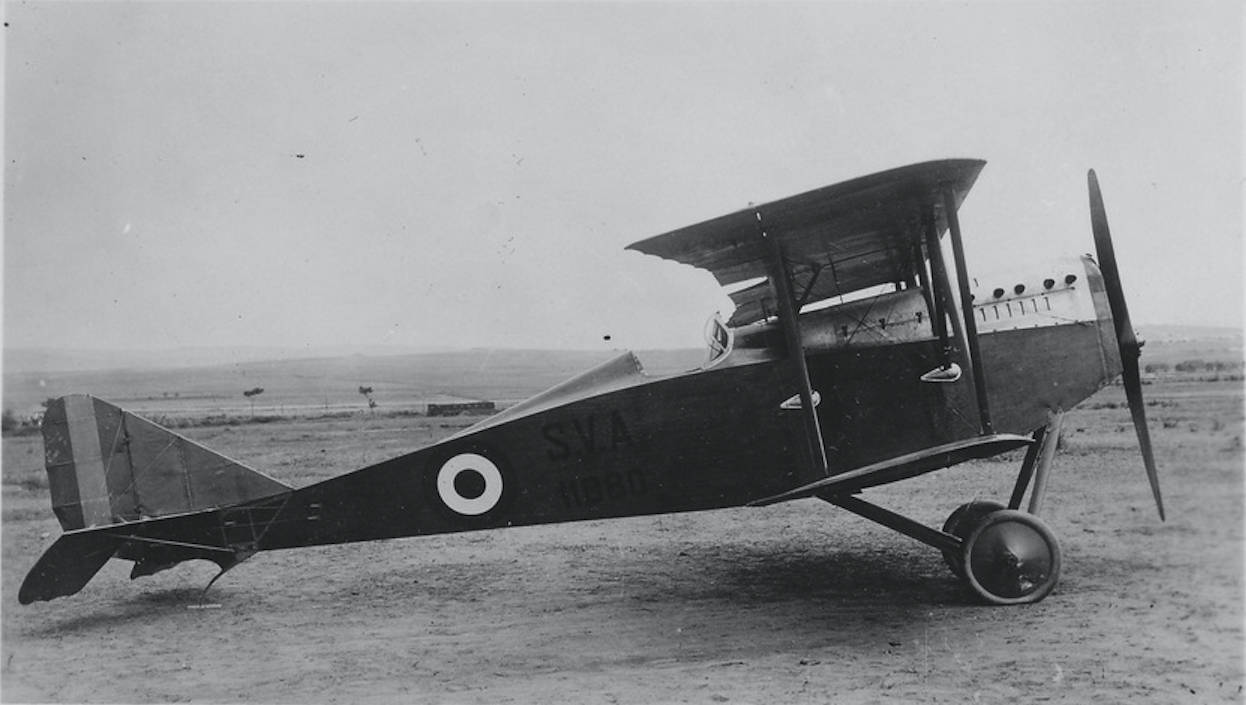Kraków 2017-12-29
History
00120a Section 1920r.
Ansaldo SVA in Poland.

The name SVA comes from Savoia-Verduzio-Ansaldo. The Ansaldo SVA family of planes are biplane airplanes from the Great World War period. Airplanes have been developed and built since 1917. Used until 1925. The production plant was located in Turin. The aircraft's constructors were engineers Umberto Savoia and Emilio Verduzio. Originally the aircraft were intended as fighters. However, the planes were not very maneuverable. But the impressive top speed, high rate of climb, high operating ceiling and long range made the plane perfect for reconnaissance and light bomber. The plane was the fastest combat airplane during the Great World War.
Ansaldo SVA were created in the following variants: SVA 1 (prototype), SVA 2, SVA 3, SVA 4, SVA 5 (the most popular), SAV 6, SVA 7, SVA 8, SVA 9, SVA 10. The last two were popular. The SVA is a conventional camera made primarily of wood; both the fuselage and the wings. The plane, however, has unusual "W" shaped struts between the Warren Truss system wings. As a result, some wire stiffening tensions were eliminated. However, it comes at a cost with greater mass and greater disturbance of the airflow between the wings.
The design of the SVA-9 reconnaissance and bombing aircraft, as well as the SVA-10 aircraft, which did not differ much from it, were changed in such a way that the size of the cabin was increased, so that it could accommodate two people. After the Great World War, in addition to Italian aviation, SVA-9 and SVA-10 aircraft were used by the aviation of the USA, Argentina, Ecuador, Peru, Lithuania and Poland.
Ansaldo SVA in Poland.
In mid-1919, the Polish Military Mission in the United Kingdom of Italy, with its head, General Eugeniusz Kątkowski, bought 80 SVA-9 and SVA-10 aircraft in Italy. They were delivered by rail to Krakow, where they were assembled at the Rakowice (Czyżyny) airport, and in 1920, they were distributed to intelligence squadrons and aviation schools. On these planes, Polish crews took part in the Polish-Bolshevik war, including the 12th Intelligence Squadron. They were also used in the intelligence squadrons of the 2nd Aviation Regiment. The planes were operated in the Polish Army until 1924.
On the blog titled "Życie i Technika" by Mr. Tomasz Jakubec, there is such information:
After the first batch of Ansaldo SVA 9, 10 aircraft was delivered to Krakow and their assembly, Italian pilots tested the aircraft. On February 7, 1920, around 5:00 p.m., a tragic accident happened. The Italian pilot Canuto Mafimo, demonstrating the efficiency of the plane and wanting to show his aviation skills, demonstrated a daring flight. It flew relatively low and, for unknown reasons, fell into a group of nearby soldiers, killing four of them. The fifth soldier standing nearby suffered a broken arm. The pilot himself fell out of the airplane and suffered numerous external and internal injuries. The unconscious was taken to hospital in a serious condition.
Ansaldo SVA design.
Combat aircraft, two-seater, single-engine, biplane, wooden structure with open cabins and a fixed landing gear.
Double-girder wings with canvas cover. Stands in the rarely used "W" arrangement were mounted between the panels. They are made of steel pipes with a drop cross-section. Concave-convex leaf profile.
Fuselage. Wooden, rebate construction, covered with plywood, and sheet metal in the vicinity of the engine. Triangular cross-section of the fuselage with the tip at the bottom. Chassis with a split axle (two-axle), additionally stiffened with struts in the V-arrangement. Rubber cord amortization, and the tail skid made of a half-spring.
Liquid-cooled in-line engine. The SAV 9 planes were powered by the 220 HP (162 kW) SPA-6A in-line 6-cylinder engines. The SAV 10 planes were powered by the 250 HP (184 kW) 6-cylinder Isotta-Fraschini V6 in-line engines.
Aircraft armament; 1 machine gun operated by a pilot and 1 machine gun operated by an observer.
T-T Ansaldo SVA 9/10 data:
Span 9.10 m. Length 8.10 m. Height 2.65 m. Bearing area 26.90 m 2. Own weight 710 - 730 kg. Take-off weight 1,055 - 1,065 kg. Payload 300 kg. Top speed 210 - 215 km / h. Cruising speed 170 km / h. Rate of climb 4.4 m / s. Service ceiling 5,650 - 5,800 m. Range 400 - 425 km.
Tally.
In mid-1919, the Polish Military Mission in the United Kingdom of Italy, with its head, General Eugeniusz Kątkowski, bought 80 SVA-9 and SVA-10 aircraft in Italy.
Written by Karol Placha Hetman
